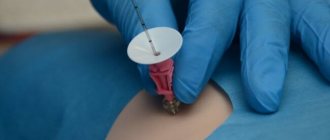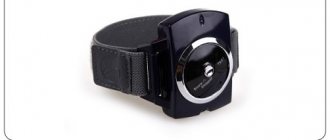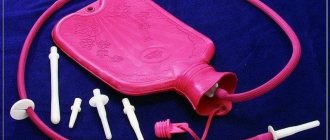home
/
Articles
/
How to give an injection at home: detailed instructions
During the treatment process, patients are often faced with the need to schedule a course of injections. Of course, they immediately wonder how much an intramuscular injection at home costs, but only a specialist can give the exact price, focusing on the type of drug, injection and duration of the course.
What types of injections are there?
Depending on the purpose for which experts prescribe injections, there are also types of injections:
- intradermal;
- subcutaneous;
- intramuscular;
- intravenous;
- intra-arterial;
- intraosseous;
- parabulbar.
It is impossible to answer clearly how much it costs to give an injection at home, because they all differ in the complexity of administration, as well as in the type of medicinal solutions.
Departure is paid separately - from 550 rubles
Request a call
Call:
+7 (499) 455-08-05
Subcutaneous injections are more effective than, for example, taking drugs by mouth, since they are easily absorbed through the loose tissue under the skin and also do not cause any harm. This is mainly the area of the shoulders, under the shoulder blades, the lower area of the armpit, hips, and also some areas of the abdominal cavity.
Intramuscular injections are a popular method of injection therapy. Muscles allow solutions to be distributed evenly and quickly throughout the body, since they are intertwined with a network of blood vessels, and the drug, entering the blood, maintains an equal concentration for several hours, which means it provides a fairly long-lasting effect. Due to the characteristics of the injection, places with a significant muscle layer are selected, as a rule, these are the gluteal areas, the anterior surface of the thigh or the deltoid muscle.
Intravenous injections are given so that the solution goes directly into the blood. Specialists often choose the ulnar veins, since they are located quite close to the surface, as well as the carpal and forearm veins, less often in the lower parts of the body. During these injections, it is especially important to follow antiseptic rules and sanitary standards.
When might such a need arise?
An injection into the thigh is one of the ways to administer drugs intramuscularly. It allows you to deliver the drug to the body, bypassing the digestive organs. When performing intramuscular injections, medicinal substances quickly reach problem areas. If you need to give an injection into a muscle, then most often the injection is given in the upper outer square of the buttocks. But it’s much easier to inject yourself in the leg yourself.
If possible, it is better to give preference to medications that can be taken orally. Studies have shown that their effectiveness does not depend on the method of entry of the active substances into the bloodstream. But injections will need to be done if:
- the drug is available only in the form of products intended for injection;
- the patient’s integrity of the mucous membrane of the stomach and esophagus is compromised;
- It was revealed that the process of absorption of substances in the intestine is disrupted.
If an injection is given in the thigh or buttock, the drugs begin to act faster, since they do not have to pass through the gastrointestinal tract. Therefore, doctors sometimes prefer this form of drug administration.
Can all types of injections be given independently?
Many patients, when faced with the need to set up a course of injections, believe that injections at home are an easy process, but this is not so. If, for example, intramuscular injections do not pose a serious danger, and it is quite easy to do them even for yourself, then intravenous injections should be entrusted only to specialists. First of all, because they require a professional approach: it is not always easy to find a vein and it is very easy to leave bruises, and intravenous injections carry a much greater danger in terms of the likelihood of infection and infection.
To protect yourself, it is better to entrust any injection to a medical professional; besides, it is not necessary to go to the hospital; you can use the service of paramedics to administer injections at home.
For preventive purposes, it would be a good idea to take a massage course from qualified specialists at our clinic. Not only can it help cope with the consequences of poor conditions (bruises, hematomas, etc.), but it will also improve overall well-being.
Call a nurse now
Call a doctor at home
You can call a doctor online, we will call you back to clarify the procedure and arrival time.
Even a simple consultation or routine examination requires one thing - time. Patients have to set aside several hours and travel specifically to a clinic or city hospital, not to mention full-scale procedures that must be performed regularly.
A fast and affordable alternative is a doctor at home from Doctor Mos! Our specialists will arrive at a time that is convenient for you, and then carry out comprehensive work - from diagnostics to professional medical care.
Preparing for the injection
In order to give an injection at home, you should take everything you need in advance:
- cotton balls or disks;
- syringe;
- a drug with a normal shelf life.
For intramuscular injections, experts recommend choosing long needles, because short options can cause inflammation, since the substance will not be injected into the muscles, but subcutaneously.
A number of requirements are put forward to the one who will give the injection. First of all, these are hygiene standards:
- wash your hands thoroughly with soap and treat them with an antiseptic or special alcohol wipes, use gloves;
- it is forbidden to reuse syringes and needles;
- prepare the workplace: you should place all the tools nearby so that you can easily use them if necessary.
Then the next stage begins - working with the drug. As a rule, the ampoule should be shaken before use and it is advisable to wipe it with alcohol. To open this type of packaging, special nail files are used, and it is more convenient to break off the tip using a piece of cotton wool.
Departure is paid separately - from 550 rubles
Request a call
Call:
+7 (499) 455-08-05
Then you need to carefully draw up the required amount of medicine, turn the syringe over and lightly tap it, this helps to collect air at the top of the syringe. To completely get rid of it, you need to slowly and effortlessly press the plunger, releasing the bubbles through the needle. The air comes out when the first drop of the substance appears from the syringe.
Certain rules have also been formulated for the patient: he must take a comfortable position in which it will be convenient for both the medical worker or relative to give the injection, and the patient himself can spend a sufficient amount of time, because some injections do not involve sudden physical activity immediately after the injection. For convenience, it is better to alternate the buttocks or other areas in which the injection is given.
How to give an injection
The cost of giving an injection in medical institutions depends on many factors, for example, the type of injection, the complexity of the injection and medications, etc. But some people prefer to complete the course on their own, especially in cases where the hospital is far from home.
How to give an intramuscular injection
Most often, patients resort to intramuscular injections; they are easier to administer at home, and no additional equipment is required.
It is most convenient to give injections in the gluteal muscle. For the correct injection, it is important to conditionally divide the buttocks into 4 parts, and select the upper right zone for the injection to avoid damage to the sciatic nerve. Next stage of production:
- you need to take a few pieces of cotton wool and lubricate the injection site with alcohol;
- then you should place the syringe in your right hand and stretch the skin at the injection site;
- the hand with the syringe is retracted 90 degrees relative to the surface and the needle is quickly inserted three-quarters into the muscle;
- then you should gently press the syringe plunger, slowly injecting the medicine (in some cases, outdated syringes have to be held with both hands);
- After administering the drug, you need to press cotton wool soaked in alcohol to the injection site and remove the needle with a sharp movement, maintaining the same 90-degree angle (the attached ball helps prevent infection and infection).
After this, you can massage the muscle with light movements for some time; this will not only help to better distribute the medicine, but also avoid the formation of bruises and hematomas.
Sometimes situations arise when it is not possible to seek the help of specialists, and there are no relatives nearby who could administer the injection. In emergency cases, you have to give the injection yourself. There are also a number of rules for self-administration: injections are most often placed in the outer thigh. To do this, you need to sit on a chair and relax your leg. The injection is made in the middle third of the thigh from the outside.
The drug is administered in a similar way, but it is important to ensure that only the fat layer gets into the fold, and not muscle tissue. Don’t forget to treat your skin with alcohol before and after injection.
How to give an intravenous injection
Intravenous injections are much more difficult to administer at home. Of course, it is better to go to a medical center or call a specialist at home, but if this is not possible, then it is important to do everything carefully.
Departure is paid separately - from 550 rubles
Request a call
Call:
+7 (499) 455-08-05
Intravenous injections are administered in the direction of blood flow; a noticeable wide vein in the elbow area is selected for injection. As with any other procedure, careful preparation is needed: treatment of the skin area, a tourniquet bandage slightly higher from the injection site. Next, you need to feel the vessel, place the needle at an angle of 45° and carefully insert the needle. It is better to choose imported samples, they are sharper and thinner. The solution is injected slowly, after the injection the area is clamped with a cotton swab. To avoid the formation of hematomas, experts recommend bending your arm at the elbow and holding it for a while.
Possible complications
Improper execution of an intramuscular injection can cause various complications: from minor to painful. Therefore, it is better to familiarize yourself with possible ones even before they appear:
- Hematoma
. Forms when the needle touches a blood vessel or when the drug is injected too quickly. Prevention of minor hemorrhages is to use sufficiently sharp needles for injections and adherence to the correct technique. If a hematoma has already formed, you need to apply an alcohol compress to it. To speed up the resorption of hematomas, you need to apply ointments specially designed for this. - Infiltrate
. A sign of infiltration is thickening and pain at the injection site. They occur due to multiple injections in the same place and due to incorrect technique for administering the medicine. In order not to provoke the occurrence of infiltration, it is necessary to carefully select injection sites, change them, control the temperature of the injected drugs and carry out all manipulations correctly. If infiltration occurs, it is recommended to apply a warm compress to it. The iodine mesh also speeds up the resorption of seals. - Needle breakage
. This can happen due to severe tension in the muscles during the injection process, due to poor quality of the needle, and also due to the insertion of the needle all the way to the cannula. To avoid breaking the needle, it must be inserted to a depth of no more than 2/3 of its length. The patient must lie down during the procedure. If the needle breaks, you need to use tweezers to pull it out. If the fragment gets too deep under the skin, you need to see a doctor to have it surgically removed. - Abscess
. If you do not follow the rules of disinfection, an abscess may develop - purulent inflammation. Signs include redness of the skin, pain, and increased general temperature. To prevent an abscess, it is necessary to follow the rules of asepsis. If a complication has already occurred, surgical intervention is prescribed.
If you cannot get rid of a post-injection complication on your own, be sure to see a medical professional.
We wish that the necessary injections are always easy and painless for you.
Itching and pain at the injection site
Sometimes after an injection, patients may experience unpleasant consequences: itching, redness or pain. There are many reasons for this: individual intolerance to the components of the drug, incorrect placement of the injection and improper care of the injection site, skin regeneration. As a rule, these sensations disappear 3-5 days after administration of the drug, but if the symptoms do not disappear, you should immediately consult a specialist.
Of course, it is better to find out in advance at the medical center how much the injection costs, but if this is not possible, then before administering the injection at home, you need to study all the rules in detail.
Tips, notes, life hacks
If the injection is painful, inject the medicine slowly. It seems that the faster, the sooner a person will be exhausted, but in fact, a slow introduction is more comfortable. Average speed: 1 ml per 10 seconds.
Don’t be afraid to treat the ampoule, hands or skin with an antiseptic once again. Here it is better to overwork than to underwork.
If you need to change needles after drawing up medication, do not remove the cap from the new one until you install it on the syringe. Otherwise, you can inject yourself. For the same reason, never try to cap a needle if you have already removed it.
If you don't know how hard to stick a needle, at least practice on chicken fillet. Just to understand that it's not scary.




